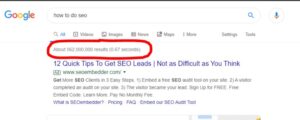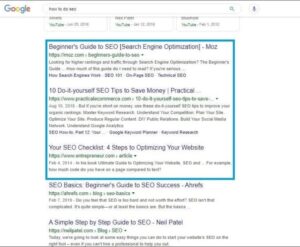Why do businesses need SEO?
Search Engine Optimization or SEO services, when done properly, can drive lots of visitors to your website. SEO traffic or visitors are most likely the ones that can quickly become customers to your business.
Remember, you have set up your website so your business can be found online. But setting up a website on the internet is not enough because your competitors are there too.
When people searching for your products or services can’t find you online and instead find your competitors — you need to have SEO for your business.
New to SEO? Read on to find out more.
Go Deeper: More Resources on SEO:
- What is SEO
- What does SEO Stand For
- What is Social SEO?
- The Ultimate Guide To Organic SEO
- The Top Local Search Ranking Factors
- Technical SEO and How it Affects Your Website’s Rank
- How Does SEO Work for Your Business?
- SEM vs. SEO: Tapping Your Business Potential
- White Hat SEO vs. Black Hat SEO: Are You Doing SEO Right?
- Easy Guide to Getting Local SEO to Work for Your Small Businesses
- Small Business SEO: Are You Optimizing the Right Way?
- The Importance of NLP and What It Means For SEO
- The On-page SEO Checklist
- Keyword Research Mastery: The Beginners Guide
- The Ultimate Google Algorithmic Penalty Recovery Guide
- Questions you SHOULD Ask Before Hiring an SEO Expert
- The 5 Step Beginner Guide to SEO Writing That Ranks
How do search engines work?
To better understand how SEO works, we must first understand…
What is a search engine and how it works?
A search engine is an internet-based computer program designed to seek and retrieve answers based on an internet user’s query.
As of today, there are about 1.94 billion registered websites all over the internet. To sort through all of this, we rely on search engines to find what we want.
Over the years, search engines have improved a lot that 90% of internet users rely on them to find answers.
There are other search engines on the internet, but about 90% of all searches are conducted on all Google platforms. In other words, Google is widely used all over the world than any other search engine.
How does Google work?
When you type in a query, Google isn’t going out to the world wide web to run your search in real-time. Billions of websites are already on the internet, and hundreds more are created every single minute.
If Google had to look through every single webpage to find the answer you are looking for, the whole process would take forever.
Search engines continuously scan the world wide web in advance to record the information that might help in your search later.
That way, when you look up “California sandals,” Google already has what it needs to answer your query in real-time.
Crawling and Indexing
The internet contains billions of webpages connected by hyperlinks.
Search engines are continually running a program called “crawler” or “spider.” Spiders crawl the pages on your site to collect information about them.

Each time the spider finds a hyperlink, it follows that hyperlink until it has visited every webpage it can find on the entire internet.
For each page that the spider visits, it records any information it might need for queries that users might lookup. The data collected are added to a particular database called a Search Index.
Page Rank
The position of a webpage on a SERP (search engine results page) is determined by what is referred to as Page Rank. Every webpage has a ranking for particular search terms or keywords.
In general, web pages are ranked based on their relevance to a search query. The order of webpages shown in the result goes from the most relevant to the least relevant.
However, to determine which webpages deserve to land on the top search results, Google uses webpage Ranking Factors.
How does Search Engine Optimization (SEO) work?
SEO works by positioning your website to the top search engine results so people can easily find it online.
Why is it important for a website to be on the top search results?
When an internet user types in a search phrase or keywords in Google and other search engines, they’ll get a long list of results. And by a long list, we mean millions of webpages.

In the organic or natural search result, most people only click on the top 3. They might click on the rest of the ranks but hardly ever click past page 1.

Most of the time, if searchers don’t find what they’re looking for, they’d just start from scratch with the new search rather than clicking through endless result pages.
Therefore, your website must appear on the top search engine results if you want more sales for your business.
Site Maps and Indexing
Business owners with a new website need to submit their sitemap to Google Search Console.
Sitemaps contain a list of all the webpages on your site. It is designed to help search engines discover the pages on your website and the location of your content. When Google understands what your site and content are all about, it will then start serving your content to relevant queries.
After Google is done indexing your website, spiders can start crawling your webpages and getting them ranked in the search results.
But SEO doesn’t end here. Remember that you have competitors, and they are also working their way to the top search results.
And this is where On-page and Off-page Optimization comes in.
On-page Optimization (On-Page SEO)
As the name suggests, this process is the optimization done within your webpages. On-Page SEO is like telling Google and internet users that your website has relevant, helpful, and useful content.
Make sure that you have arranged the answers for the topic and keywords that will make it easy for internet users to read and understand your content.
For instance, if your site is about barbecue, make sure you have quality content that has the proper keywords in the heading, in the body, in the image descriptions, and so on.
You also have to use LSIs or supporting keywords in it like:
- BBQ recipes
- Best BBQ grills
- grill temperatures
- types of meat
Compared to Off-Page SEO, On-page SEO is easier to deal with since most of the changes needed are within your control.
On-Page Optimization starts with…
Keyword Research
Determining the keywords for your business is crucial to the success of your SEO campaign. You can use research tools from websites such as Ahrefs.com and Ubersuggest.

The goal of your keyword research is to discover how much traffic there is for a specific keyword and find out how many businesses are competing for that keyword.
Content Management Systems and SEO Plugins
An easy way to create high-quality web content while optimizing for search engines like Google is to use a CMS or Content Management System.
WordPress is a well-known and SEO friendly CMS. Partnered with the Yoast SEO plugin, WordPress can guide you in making your content readable and search engine friendly.
To make your content easy-to-read and understand you will be asked to use:
- A heading and subheadings
- Highlighted words (colored, bold, or italicized words)
- Short paragraphs that contain 1 to 3 sentences. The whole point is to have a single idea in one paragraph.
- pyramid structured content
- Bulleted lists and Paragraphs containing not more than 300 words
For On-Page Optimization, WordPress and Yoast will guide you in creating:
- An SEO Title or title tag
- A Meta Description or meta tag
- External links
- Internal links
- Alt image tags
Off-Page Optimization (Off-Page SEO)
Off-Page Optimization simply means that you are making sure that authoritative websites are linking back to you. You can not control Off-Page SEO since it is up to the other sites if they link back to you.
Here are Off-Page SEO factors that influence your search engine ranking:
Social – Likes and shares done on social media sites is an essential Off-Page SEO factor. Always make sure to produce more high-quality shareable content to help boost your website’s SEO.
Links – Links building is one of the best practices for Off-Page SEO that can help your website show up into the top search engine results. However, be careful not to engage with spamming sites, or your website could end up getting banned by search engines.
Trust – Google values legitimate websites that internet users can trust. Google rewards those websites by improving their search engine rankings. So, try to build high-quality backlinks from authoritative sites to gain more trust from internet users.
White Hat vs. Black Hat SEO
In the world of SEO, there are website owners that follow the rules or the Webmaster Guidelines. And some try to bend or break the rules.
SEO done by following Google’s Webmaster Guidelines is referred to as White Hat SEO.
On the other hand, the practice of creating webpages and using prohibited SEO methods to show up in the search results quickly is considered as Black Hat SEO.
In the pursuit of “good user experience,” Google has been rolling out updates to eradicate poor SEO practices to serve its customers — the internet users better.
Local SEO
If you haven’t claimed your Google My Business listing, you should claim it as soon as possible, as it is the foundation of Local SEO. Optimizing your website’s online presence using Local SEO can help attract more customers to your business.
Digital Marketing and Search Engine Optimization (SEO)
Many businesses practice digital marketing since many people are always online using digital technologies such as mobile phones and other digital medium.
To take a step further, digital marketers now use SEO to drive more customers to businesses using Facebook, Instagram, ShareASale, and other online platforms.
Final Thoughts
The SEO landscape is always changing. Google, as a search engine, is continuously evolving to give us the best search engine results. But the one thing that Google wants website owners to do is always to create high-quality content that adds value to internet users. SEO works! If you are in need of SEO services we are here to help.